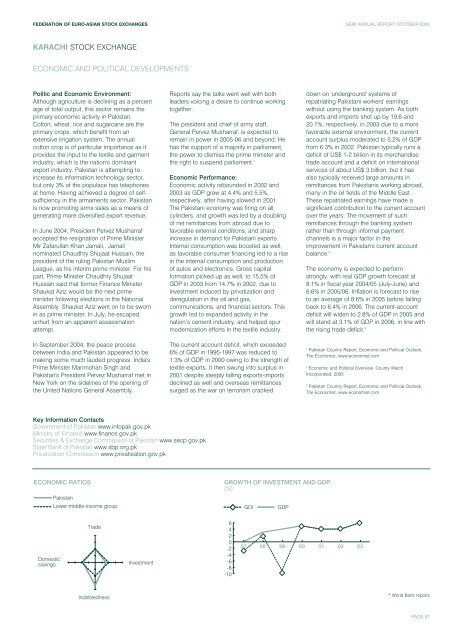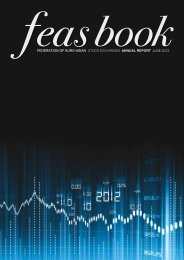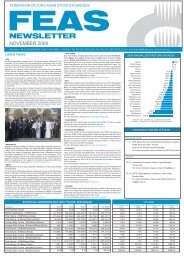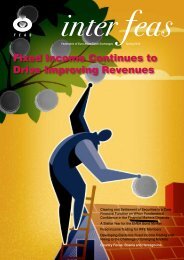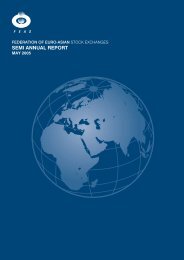Download - FEAS
Download - FEAS
Download - FEAS
You also want an ePaper? Increase the reach of your titles
YUMPU automatically turns print PDFs into web optimized ePapers that Google loves.
FEDERATION OF EURO-ASIAN STOCK EXCHANGES SEMI ANNUAL REPORT OCTOBER 2005<br />
KARACHI STOCK EXCHANGE<br />
ECONOMIC AND POLITICAL DEVELOPMENTS<br />
Politic and Economic Environment:<br />
Although agriculture is declining as a percent<br />
age of total output, this sector remains the<br />
primary economic activity in Pakistan.<br />
Cotton, wheat, rice and sugarcane are the<br />
primary crops, which benefit from an<br />
extensive irrigation system. The annual<br />
cotton crop is of particular importance as it<br />
provides the input to the textile and garment<br />
industry, which is the nation's dominant<br />
export industry. Pakistan is attempting to<br />
increase its information technology sector,<br />
but only 3% of the populace has telephones<br />
at home. Having achieved a degree of selfsufficiency<br />
in the armaments sector, Pakistan<br />
is now promoting arms sales as a means of<br />
generating more diversified export revenue.<br />
In June 2004, President Pervez Musharraf<br />
accepted the resignation of Prime Minister<br />
Mir Zafarullah Khan Jamali,. Jamali<br />
nominated Chaudhry Shujaat Hussain, the<br />
president of the ruling Pakistan Muslim<br />
League, as his interim prime minister. For his<br />
part, Prime Minister Chaudhry Shujaat<br />
Hussain said that former Finance Minister<br />
Shaukat Aziz would be the next prime<br />
minister following elections in the National<br />
Assembly. Shaukat Aziz went on to be sworn<br />
in as prime minister. In July, he escaped<br />
unhurt from an apparent assassination<br />
attempt.<br />
In September 2004, the peace process<br />
between India and Pakistan appeared to be<br />
making some much lauded progress. India's<br />
Prime Minister Manmohan Singh and<br />
Pakistan's President Pervez Musharraf met in<br />
New York on the sidelines of the opening of<br />
the United Nations General Assembly.<br />
Key Information Contacts<br />
Government of Pakistan www.infopak.gov.pk<br />
Ministry of Finance www.finance.gov.pk<br />
Securities & Exchange Commission of Pakistan www.secp.gov.pk<br />
State Bank of Pakistan www.sbp.org.pk<br />
Privatization Commission www.privatisation.gov.pk<br />
ECONOMIC RATIOS<br />
Domestic<br />
savings<br />
Pakistan<br />
Lower-middle-income group<br />
Trade<br />
Indebtedness<br />
Investment<br />
Reports say the talks went well with both<br />
leaders voicing a desire to continue working<br />
together.<br />
The president and chief of army staff,<br />
General Pervez Musharraf, is expected to<br />
remain in power in 2005-06 and beyond. He<br />
has the support of a majority in parliament,<br />
the power to dismiss the prime minister and<br />
the right to suspend parliament. 1<br />
Economic Performance:<br />
Economic activity rebounded in 2002 and<br />
2003 as GDP grew at 4.4% and 5.5%,<br />
respectively, after having slowed in 2001.<br />
The Pakistani economy was firing on all<br />
cylinders, and growth was led by a doubling<br />
of net remittances from abroad due to<br />
favorable external conditions, and sharp<br />
increase in demand for Pakistani exports.<br />
Internal consumption was boosted as well,<br />
as favorable consumer financing led to a rise<br />
in the internal consumption and production<br />
of autos and electronics. Gross capital<br />
formation picked up as well, to 15.5% of<br />
GDP in 2003 from 14.7% in 2002, due to<br />
investment induced by privatization and<br />
deregulation in the oil and gas,<br />
communications, and financial sectors. This<br />
growth led to expanded activity in the<br />
nation’s cement industry, and helped spur<br />
modernization efforts in the textile industry.<br />
The current account deficit, which exceeded<br />
6% of GDP in 1995-1997 was reduced to<br />
1.3% of GDP in 2000 owing to the strength of<br />
textile exports. It then swung into surplus in<br />
2001 despite steeply falling exports-imports<br />
declined as well and overseas remittances<br />
surged as the war on terrorism cracked<br />
GROWTH OF INVESTMENT AND GDP<br />
(%)<br />
6<br />
4<br />
2<br />
0<br />
-2<br />
-4<br />
-6<br />
-8<br />
-10<br />
97<br />
GDI GDP<br />
down on 'underground' systems of<br />
repatriating Pakistani workers' earnings<br />
without using the banking system. As both<br />
exports and imports shot up by 19.6 and<br />
20.1%, respectively, in 2003 due to a more<br />
favorable external environment, the current<br />
account surplus moderated to 5.2% of GDP<br />
from 6.3% in 2002. Pakistan typically runs a<br />
deficit of US$ 1-2 billion in its merchandise<br />
trade account and a deficit on international<br />
services of about US$ 3 billion, but it has<br />
also typically received large amounts in<br />
remittances from Pakistanis working abroad,<br />
many in the oil fields of the Middle East.<br />
These repatriated earnings have made a<br />
significant contribution to the current account<br />
over the years. The movement of such<br />
remittances through the banking system<br />
rather than through informal payment<br />
channels is a major factor in the<br />
improvement in Pakistan's current account<br />
balance. 2<br />
The economy is expected to perform<br />
strongly, with real GDP growth forecast at<br />
8.1% in fiscal year 2004/05 (July-June) and<br />
6.6% in 2005/06. Inflation is forecast to rise<br />
to an average of 8.6% in 2005 before falling<br />
back to 6.4% in 2006. The current-account<br />
deficit will widen to 2.8% of GDP in 2005 and<br />
will stand at 3.1% of GDP in 2006, in line with<br />
the rising trade deficit. 3<br />
1 Pakistan Country Report, Economic and Political Outlook,<br />
The Economist, www.economist.com<br />
2 Economic and Political Overview, County Watch<br />
Incorporated, 2005<br />
3 Pakistan Country Report, Economic and Political Outlook,<br />
The Economist, www.economist.com<br />
98 99 00 01 02 03<br />
* World Bank reports<br />
PAGE 87


